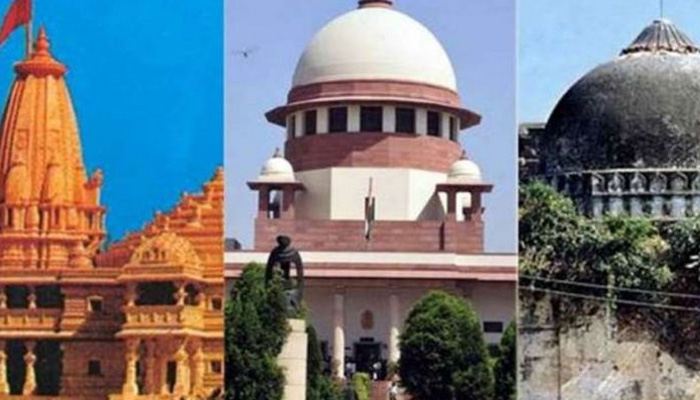TRENDING TAGS :
Ram Mandir-Babri Masjid: What will the court decide today?
Supreme Court has decided to end the Ayodhya dispute. The hearing of Ayodhya dispute is in its last leg. The Court has asked all parties to wrap their arguments today (October 16). All eyes are on the Supreme Court.
Lucknow: Supreme Court has decided to end the Ayodhya dispute.The hearing of Ayodhya dispute is in its last leg. The Court has asked all parties to wrap their arguments today (October 16) by 5 p.m. All eyes are on the Supreme Court.
ALSO READ:Action genre on Rohit Saraf’s wish list after ‘The Sky Is Pink’
Babri Masjid was built in 1528 by Mir Baqi, a Mughal general of Mughal King Babur. Hindus believe that Baqi destroyed a pre-existing Ram temple to build the mosque.
Both communities have worshipped in the 'mosque-temple'. Muslims prayed inside the previously standing structure of Babri Masjid while Hindus prayed outside.
After demolition of Babri Masjid, the dispute renewed sharply and has been embroiled in judicial battle.
Here are the argument and assertions put forth by the Muslim side. As the dispute has gone on for decades, there have been many more assertions made than those mentioned below.
- There is no direct evidence of an image of a God in Ram janmabhoomi.
ALSO READ:Guj: Mud pile causes autorickshaw-police MUV collision, 3 dead
- Report by Archaeological Survey of India (ASI) concluding that there was a temple at the site is inconclusive and riddled with inconsistencies. Travelogues by Western gazetteers made over years are mere stories. It is not a crucial piece of evidence.
- There is no claim of title of the disputed site by Hindus till 1989. And, between 1885 to 1989, no claim on the title of the land has been made. Our claim for possession is first then their (Hindu parties) claim for the title. In 1885 their claim for title was denied and till 1989 there was nothing in between.
- Possession of Ram Chabutra and Sita Rasoi by the Hindu site only gives them right to pray and not possession.
- Hindus have only exercised prescriptive right (by offering prayers), but never the title. The Muslim side has not lost the title.
ALSO READ:Pakistan: Dog that bit 25 people in Karachi are found dead
In 2010, Allahabad High Court ruled that the disputed 2.77 acre land at Ayodhya will be divided into three parts. The ruling subsequently got a stay from the Supreme Court.
Here are the few arguments put forward by the Hindu side. Considering the dispute has been going on for decades, the list below highlights only a few arguments and assertions.
- Entire claim of title and possession of Muslim sides is tainted at the source.
- The report by Archaeological Survey of India (ASI) concludes the presence of a Hindu temple below the mosque. This has been corroborated by travelogues and Gazetteers of Western visitors. All these weigh high as evidence.
- We cannot change the birthplace of Ram. There are enough mosques in Ayodhya for Muslims. Hence, their religious rights will not be affected.
- Muslim side argues that once a mosque, always a mosque. But Muslim can offer prayer even in open space
- The burden of proof is on the Muslim parties to prove that the mosque was not built on a spot which was the birthplace of Lord Ram.
ALSO READ:Nirmala Sitharaman’s husband hits out at Centre over slowdown, says govt in denial
Fourteen appeals had been filed in the apex court against the 2010 Allahabad High Court judgment, delivered in four civil suits, that the 2.77-acre land in Ayodhya be partitioned equally among the three parties -- the Sunni Waqf Board, the Nirmohi Akhara and Ram Lalla.
ALSO READ:Turning author a childhood dream, feel amazing: Rachel Goenka



